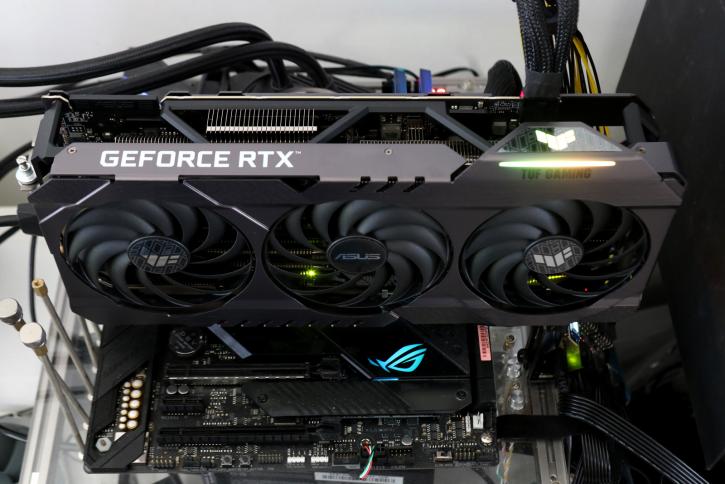Introduction
Asus GeForce RTX 3090 Ti TUF Gaming OC
A really BFGPU with a 3.5 slot - 16- pin connector design
It's been boiling and baking for a while now inside NVIDIA's kitchen, a GeForce RTX 3090 'Ti'. The 3090 flagship series now gets even faster memory, more shaders, and a TGP passing 450 Watts. This review benchmarks the GeForce RTX 3090 Ti from ASUS in a TUF OC flavor. Every board partner manufacturing RTX 30-series cards have various models. Asus offers TUF Gaming (OC) and ROG Strix variants of its monster GPUs. The build quality is awesome. The all-aluminum shroud is rigid, and the fans shut off at 55°C. When they turn back on, the changeover is relatively silent but most of all fast. The center fan rotates in the opposite direction as the outside two, Asus claims. However, when the RTX 3090 was under low strain, such as watching a YouTube video, the fans would briefly turn on and then turn off. Almost imperceptible in daily use, but not completely silent at idle. That, and 24 GB of the world's fastest GDDR6X RAM. What are the advantages of a product with beefed-up 10752 shader cores? The GeForce RTX 3090 Ti is the first graphics card to include two gigabytes of GDDR6X memory chips rated at an effective 21 Gbps data transmission rate. Additionally, it will have a new 16-pin standardized power connector. Users should ensure that their power supplies are capable of delivering 450W to the GPU alone, so we're slowly getting back to 1000W supplies, particularly when combined with other high-end desktop components. It's a bit of a beast really, and while we're not certain why graphics cards rated 450 Watt in their defaults setup (yes tweaked you could pass 500 Watts) are deemed as an acceptable thing, we certainly cannot deny the sheer rendering power that is thrown at us today. In this years CES presentation, NVIDIA teased the RTX 3090 Ti. The graphics card will make use of all 10752 shader cores on the GA102 GPU. NVIDIA has introduced 24GB of GDDR6X memory with a 21 Gbps clock speed. The maximum potential bandwidth of 1 TB/s is achieved coupled to a 384-bit memory bus, which is over 8% faster than the standard GeForce RTX 3090. The triple-slot arrangement of the Founders Edition RTX 3090 Ti is nearly identical to that of the original model. The founder card will be powered by a single 16-pin power socket with a maximum output power of 450W. The card includes a base clock of 1560 MHz and a boost clock of 1860 MHz, which is quicker than the regular 3090 model. On the GeForce RTX 3090 Ti, NVIDIA enabled 84 SM units, resulting in a total of 10,752 shader cores (82 SM / 10496 cores on the RTX 3090 Non-Ti). Of course, the GeForce RTX 3090 Ti has RT (Ray-Tracing) cores and Tensor cores. The Ampere GA102 GPU-based card was supposed to launch earlier this year already but was delayed a good month. It was 2017 when Ampere as a GPU architecture surfaced on the web, and, up to earlier this year, NVIDIA had not listed this name in any of its roadmaps on the consumer side. It was with military-level secrecy that the Ampere consumer part was developed. Ampere, of course, is the base unit of electric current in the international system of units. But the GPU is named after André-Marie Ampère, a French mathematician and physicist, considered the father of electrodynamics. NVIDIA has a track record of naming their GPU architectures after mathematicians and physicists or figures from closely related fields, of naming a few; Pascal, Fermi, Kepler, Maxwell, and, more recently, Turing. While it was no secret that the new GPUs would be based on Ampere, we've seen much discussion about fabrication nodes, architecture, and specifications. Still, everybody seems to have forgotten that Ampere already launched earlier this year for the HPC market. The first product based on Ampere was the NVIDIA Tesla A100, outfitted with a GA100 Ampere GPU based on 7nm fabricated at TSMC; that product holds 54 billion transistors 6912 Shader cores. On September 1st of the year, 2020, NVIDIA announced three initial Ampere graphics cards in its first launch wave. A week before announcements, specifications of the GeForce RTX 3080 and 3090 took a twist; the shader core count mysteriously doubled up from what everybody expected. The GPUs are fabricated on an 8nm node derived from Samsung. This process is a further development of Samsung's 10nm process; no EUV is applied in production just yet. The first wave of announcements would see the GeForce RTX 3080 and 3090 being released first, and, as a bit of a surprise, the GeForce RTX 3070 would be arriving in roughly the same timeframe as well. The initial launch of Ampere for consumers entails the GeForce RTX 3070 8GB GDDR6, RTX 3080 10GB GDDR6X, then came the 24GB GDDR6X based premium flagship, and today the 3090 Ti. The lineup nearly doubles Raytracing performance with Gen2 ray-tracing cores and 3rd iteration Tensor cores. The NVIDIA GA102 GPU was used initially for two products, the GeForce RTX 3080 and 3090 graphics cards. And it is one big GPU die and product overall alright; the 3090 Ti's GA102-350-A1 GPU is armed with 10.752 Shader processors and 28 billion transistors. In this review, we'll check out the mother of them all, the GeForce RTX 3090 Ti, paired with 24GB of updated GDDR6X graphics memory, 24 GB, and 10K+ Shader cores. The new PCI Express 5.0 — 12(+4)-pin 12VHPWR connector, can offer up to 600 watts. The GeForce RTX 3090 Ti, on the other hand, will always come with an adaptor for three 6+2 pins connectors to that new 12VHPWR connector.
Asus GeForce RTX 3090 Ti TUF Gaming OC
The TUF Gaming series GeForce RTX 3090 Ti has been fitted with fully enabled NVIDIA GA102-350 GPU; it has a hefty 10.752 Shader cores activated and is paired with 24 GB of all-new GDDR6X graphics memory. ASUS equipped the card with a semi-passive design; the three fans start to spin and cool once the GPU warms up. The card is beefed up pretty extreme. The latest generation's cooler design is a lot better than previous generations, and I'm not kidding. The ASUS TUF Gaming GeForce RTX 3090 Ti has an aluminum shroud, a massive heatsink with six heat pipes, and three Axial-tech fans, with the middle fan spinning in an opposite direction to decrease air turbulence and improve heatsink coverage. This TUF OC card revision card has a clock speed of 1920 MHz and 1950 MHz in a selected gaming mode, among the fastest on the market. The memory runs at 21 Gbps effective. The card also has a high TGP value at just roughly 460W. To amp up such hefty values, the cards have been fitted with a new single 16-pin power connector, there will be a convertible cable of 3x8 pins to this new (12+4) power connector included. Realistically with these values and other high-end components in mind, it would be best if you had at least a proper 1000 Watt PSU when using this graphics card. Weighing in at 2kg, this newborn has been sized quite big. Mind you, we test the TUF OC model, the regular TUF model simply runs reference clock frequencies. We actually recommend the cheaper non OC model, as the percentual performance difference, would be extremely little. Let's start up this review, shall we?


